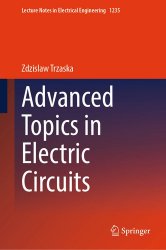 Название: Advanced Topics in Electric Circuits Название: Advanced Topics in Electric Circuits
Автор: Zdzislaw Trzaska
Издательство: Springer
Год: 2025
Страниц: 506
Язык: английский
Формат: pdf (true)
Размер: 54.8 MB
This book is addressed to researchers and practitioners in the theory and applications of electric circuits. It can also serve as a textbook for Ph.D. students examining applications of modern mathematics to important issues emerging nowadays more and more often in advanced electrical and electronic systems. The book offers effective tools to facilitate the study of all those circuits and systems increasingly penetrating our world, helping to discover their hidden beauty. The material is presented in twelve chapters divided into sections. Usually, first sections are of an introductory nature, explain studied phenomena and announce numerical results. More advanced investigations are presented in subsequent sections. The center of concern is set on existing modern methods as well as continuously emerging new methods of investigations useful for researchers, engineers and practitioners active in many interdisciplinary fields, where physics, electrochemistry, and electric circuits play a key role.
The book contains original formulations on both theoretical and practical issues and certain applications, and also provides a practical methodology for solving more complex problems related to the functioning of various electrical circuits. In particular, this concerns the analysis of complex structures of planar and spatial circuits, as well as modeling and simulation of extensive circuits operating in a dynamic state, including some issues relating to power systems. The material of the book is presented in a concise manner and takes into account the current possibilities of modern information technology and computer simulation. The lecture is richly illustrated with examples that relate to a variety of electrical circuit structures and procedures for solving them.
Artificial Intelligence (AI) is a leading computer technology of the current age of the Fourth Industrial Revolution (Industry 4IR). It possesses the ability to imitate human behavior and intelligence by machines or special arrangements. Therefore, AI-based modeling is the key to build automated, intelligent, and smart systems according to current and forthcoming needs. Artificial Intelligence appears with increasing intensity in our common day practice and increases human powers to solve many of the complex problems that labored people so far for a really long time. Artificial Intelligence aspires at emulating human intelligence on machines to make them think and behave like human beings. Presently we are at the onset of a revolution of processing large amounts of data where human intelligence and machine intelligence coexist. Very often, AI is considered to simulate human intelligence, as opposed to natural intelligence, by machines, especially computer systems. The efficiencies of AI opened up new avenues for the non-conventional models which decisively have rise to a new research branch called Computational Intelligence (CI).
Coverage includes:
• Principles of optimal operations of electrical circuits;
• The equilibrium state of the circuit as a stationary point of its power functional;
• The Gibbs effect and its consequences for circuit analysis; • Accurate calculation of complex dynamic circuits operating in non-sinusoidal periodic states;
• Energy hysteresis loops in non-sinusoidal periodic states of circuits;
• Optimal transformations of elements in three-phase circuits;
• Analog and digital filters;
• Fractals and their structures and measures;
• Fibonacci, Sierpiński and Cantor circuits;
• Chaos in electrical circuits;
• Electrochemical impedance spectroscopy;
• Circuits with nanostructures and their properties;
• Circuits of fractional orders;
• AI in electrical circuits.
This is the first extensive description of these topics and the interpretations of analytical results and those obtained from computer simulations with MATLAB environments. Special attention is paid to nonlinear electric circuits and finally the presentation is extended to effective applications of the achievements of modern AI. Numerous examples and exercises illustrate main results of the book. The book provides readers with a better understanding of origins and properties of many new circuit structures made possible by nanotechnology and atomic microscopy.
Скачать Advanced Topics in Electric Circuits
|